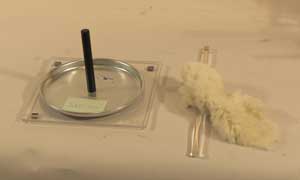|
Size: 630
Comment:
|
Size: 2551
Comment: converted to 1.6 markup
|
| Deletions are marked like this. | Additions are marked like this. |
| Line 1: | Line 1: |
| = Electrophorus 5A10.20 = | #acl snarf:read,write,delete,revert,admin FacultyGroup:read,write All:read = Electrophorus, 5A10.20 = |
| Line 3: | Line 4: |
| Electrophorus = "charge-bearer". Place flat acrylic plate on grounded conducting plane (not shown). Rub plate with fur to charge it negative. Place electrophorus on plate, momentarily ground top surface of electrophorus. |
'''Location:''' * '''Cabinet:''' Electrostatics (ES) * '''Bay:''' (A2) * '''Shelf:''' #1 |
| Line 8: | Line 9: |
| Remove electrophorus. Potential of electrophorus may be as high as 30 kV | {{attachment:Electrophorus_5A1020.jpg}} |
| Line 10: | Line 11: |
| The department has two electrophoruses of different sizes. | '''Description:''' |
| Line 12: | Line 13: |
| More info on the electrophorus: | Invented in 1764 by Johan Wilcke and was improved by Alessandro Volta 11 years later, the Electrophorus or Capacitive Generator produces an electrostatic charge from a process call induction. The Electrophorus is also called a "charge-bearer" and the electrical potential of an Electrophorus can be as high as 30 kV. |
| Line 14: | Line 15: |
| http://www.ece.rochester.edu/~jones/demos/electrophorus.html | ||<:style="width: 60%" :40%>'''Equipment'''||<:30%>'''Location'''||<:25%>'''ID Number'''|| || || || || ||Electrophorus (Small)||[[ElectrostaticsCabinetA1A2| ES, Bay A2, Shelf #1]]||5A10.20.a || ||Electrophorus (Large)||[[ElectrostaticsCabinetA1A2| ES, Bay A2, Shelf #1]]||5A10.20.b || ||Rabbit Fur||ES, Bay A1, Shelf #1|| || |
| Line 16: | Line 21: |
| attachment:Electrophorus_5A1020.jpg | '''Setup:''' 1. There is no setup procedure |
| Line 18: | Line 24: |
| [:Electrostatics:Electrostatics] | '''Cautions, Warnings, or Safety Concerns:''' 1. Our large Electrophorus can deliver a potential as high as 30 kV and can be an unpleasant shock but not too harmful. |
| Line 20: | Line 27: |
| [:Demonstrations:Demonstrations] | '''Demonstration:''' |
| Line 22: | Line 29: |
| [:Instructional:Home] | Small Electrophorus: 1. Place flat acrylic plate on grounded conducting plane (not shown).??(Check) * Rub the acrylic plate with the rabbit fur. This will negatively charge the acrylic plate. * Place Electrophorus on plate * Momentarily ground top surface of electrophorus to the same grounding plate that the acrylic plate is on.??(Check) * Lift the electrophorus off the acrylic plate. * Bring your finger to close to the electrophorus and a spark will jump. * To repeat, start at step 3. Large Electrophorus: 1. Rub the glass plate with the rabbit fur. This will negatively charge the acrylic plate. * Place Electrophorus on plate * Momentarily ground top surface of electrophorus using the pice of alummum foil coming from the grounding plate benieth the electrophorus. * Lift the electrophorus off the glass plate. * Bring your finger to close to the electrophorus and a large spark will jump. * To repeat, start at step 2. ||attachment other photos||attachment other photos|| ||attachment other photos||attachment other photos|| '''References:''' 1. [[http://www.ece.rochester.edu/~jones/demos/electrophorus.html|Jones, Thomas B. (July 2007). "Electrophorus and accessories". Univ. of Rochester.]] 2. [[http://en.wikipedia.org/wiki/Electrophorus|Wikipedia]] [[Electrostatics]] [[Demonstrations]] [[Instructional|Home]] |
Electrophorus, 5A10.20
Location:
Cabinet: Electrostatics (ES)
Bay: (A2)
Shelf: #1

Description:
Invented in 1764 by Johan Wilcke and was improved by Alessandro Volta 11 years later, the Electrophorus or Capacitive Generator produces an electrostatic charge from a process call induction. The Electrophorus is also called a "charge-bearer" and the electrical potential of an Electrophorus can be as high as 30 kV.
Equipment |
Location |
ID Number |
|
|
|
Electrophorus (Small) |
5A10.20.a |
|
Electrophorus (Large) |
5A10.20.b |
|
Rabbit Fur |
ES, Bay A1, Shelf #1 |
|
Setup:
- There is no setup procedure
Cautions, Warnings, or Safety Concerns:
- Our large Electrophorus can deliver a potential as high as 30 kV and can be an unpleasant shock but not too harmful.
Demonstration:
Small Electrophorus:
- Place flat acrylic plate on grounded conducting plane (not shown).??(Check)
- Rub the acrylic plate with the rabbit fur. This will negatively charge the acrylic plate.
- Place Electrophorus on plate
- Momentarily ground top surface of electrophorus to the same grounding plate that the acrylic plate is on.??(Check)
- Lift the electrophorus off the acrylic plate.
- Bring your finger to close to the electrophorus and a spark will jump.
- To repeat, start at step 3.
Large Electrophorus:
- Rub the glass plate with the rabbit fur. This will negatively charge the acrylic plate.
- Place Electrophorus on plate
- Momentarily ground top surface of electrophorus using the pice of alummum foil coming from the grounding plate benieth the electrophorus.
- Lift the electrophorus off the glass plate.
- Bring your finger to close to the electrophorus and a large spark will jump.
- To repeat, start at step 2.
attachment other photos |
attachment other photos |
attachment other photos |
attachment other photos |
References: